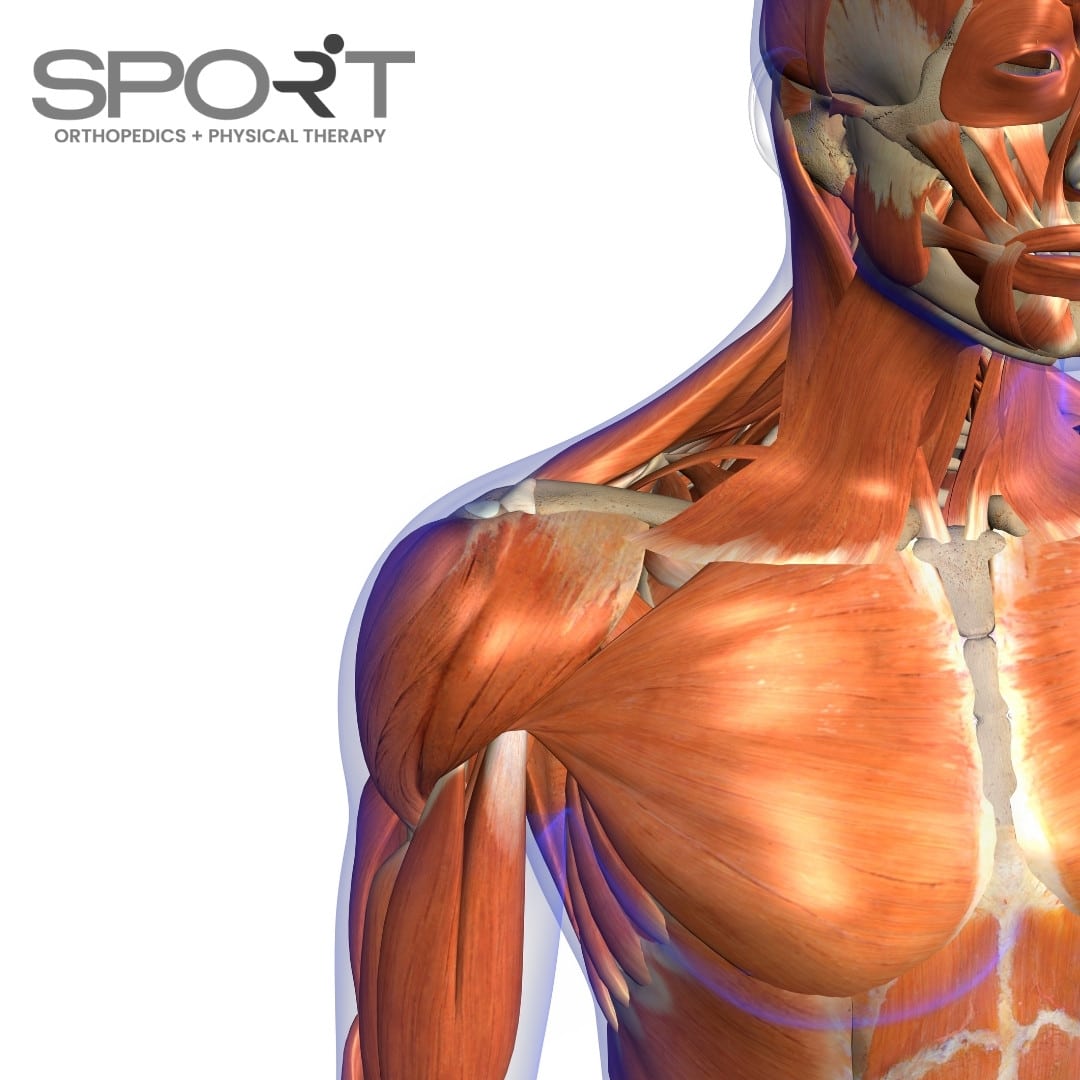Open Shoulder Instability Surgery in Dallas and Frisco
Bankart Repair Procedure, Latarjet Procedure
Open Shoulder Instability Surgery
It’s difficult for us to live our lives with pain or joint instability. This is especially true if that discomfort occurs in the shoulder socket. If you suffer from shoulder stiffness, broken bones, a damaged labrum, rotator cuff tears, or another shoulder injury, you could experience chronic shoulder instability. Luckily, the experienced team at SPORT Orthopedics and Physical Therapy are here to offer treatment. One very effective option is open shoulder instability surgery. There are two major forms of this procedure: the Bankart repair and the Latarjet procedure.
At SPORT, we not only offer surgical solutions, but we also offer physical therapy in Frisco and Dallas. Our team is a well-rounded group of providers who all have the same goal in mind: getting you back in the game. If you experienced a shoulder injury and struggle with instability, we invite you to schedule an appointment with us. We’ll bring you in for a physical examination and evaluate your situation to determine whether or not you need a shoulder surgeon. Call our office today at 469-200-2832 to schedule with our sports medicine team.
Shoulder Anatomy
Our shoulder joint is one of the most complex joints in the human body. The shoulder joint consists of three bones: the humerus (upper arm bone), the scapula (shoulder blade), and the clavicle (collarbone). The way the bones move together makes up the shoulder joint. Our shoulder joint, also known as the glenohumeral joint, is a ball and socket joint. It is where the upper arm bone attaches to the shoulder blade, and the top of the arm bone (the ball) sits in the cavity of the shoulder socket. The labrum lines the socket. It is a cartilage that helps the shoulder joint move without friction.
Our shoulders have an extreme range of motion, which makes them incredibly important in our daily lives. They act like hinges to allow the arms to move up and away from the body, fully rotate the arm 360 degrees, and rotate the shoulders. Shoulder muscles also allow us to push, pull, and do any heavy lifting. Since the shoulder has such a wide range of motion, this makes the shoulder unstable and more prone to dislocation than any other joint.

What Causes Shoulder Instability?

Shoulder instability events are also called dislocations. Shoulder dislocation occurs when the humeral head becomes detached from the socket either partially or completely. During the injury, it can also cause stretched ligaments, damage to the surrounding soft tissues, and a torn labrum. The muscles and tendons surrounding the shoulder joint can also be compromised. This dislocation can be the result of a fall, sports injury (especially from contact sports), or car accident. A dislocated shoulder is a common injury and can cause pain and a limited range of motion.
Once the shoulder is injured and becomes dislocated, the shoulder is more prone to a repeat injury in the future. Repeat injuries are called recurrent instability or recurrent dislocations, and you may suffer from shoulder pain or need physical therapy to help prevent future injuries.
Frequent shoulder dislocations can cause chronic shoulder instability. In many shoulder dislocations, the chance of a nerve injury is likely. This often causes severe pain and multidirectional instability. If the damage is too severe for a nonsurgical option, your doctor will likely recommend a surgical repair.
Treatments for Shoulder Instability
If you think you may have dislocated your shoulder, it is important to seek medical attention immediately. The initial shoulder dislocation is typically treated by doing a closed reduction. A closed reduction is used to set the bone without making an incision. This can be done in an emergency room.
Many shoulder injuries can be treated non-surgically. These treatment options include seeing a physical therapist, rest, and pain medications to reduce pain, as well as treat swelling and inflammation.
Surgical procedures are divided into 2 types. The most common minimally invasive procedure is the arthroscopic Bankart repair. This is where orthopaedic surgeons insert a small tube with a tiny camera into the joint through a small incision. This is a minimally invasive surgery and an outpatient procedure. The other option is a latarjet procedure.
Open surgery is for cases too severe for an arthroscopic repair, or if arthroscopic surgery has been performed and shoulder weakness or instability persists. We discuss the two options in more detail below.
Open Shoulder Instability Surgery

Open surgery means that there is a single incision made above the shoulder joint that a surgeon uses to access the injured area. It is also recommended for patients who are young and highly active. Fixing the shoulder instability early on can prevent severe pain and prevent recurrent shoulder injuries.
Open surgery can repair or tighten damaged structures after a shoulder dislocation, or if the dislocation has caused damage to the bones in the joint. To repair the bone itself, the surgeon uses a bone graft, made from a bone from another part of your body. The surgeon uses the bone graft to make the rim of the glenoid socket larger, so fewer shoulder dislocations occur in the future.
Latarjet Procedure
A common type of open surgery for shoulder instability is the Latarjet procedure. This type of open surgery is typically recommended for patients who have bone loss during dislocation or chronic shoulder instability. During a Latarjet procedure, an orthopedic surgeon will take a piece of bone from the front of the shoulder and use it to replace bone that was lost around the socket. This procedure deepens the socket and moves several tendons to the front of the shoulder to help prevent abnormal movement and recurrent dislocations.
Arthroscopic Bankart Repair
The most common form of ligament injury in the shoulder is called a Bankart lesion. Bankart lesions occur when ligaments at the front of the shoulder joint capsule are torn. An arthroscopic bankart repair is the most effective way to repair this shoulder problem. To repair a Bankart lesion, the surgeon must attach the torn piece of tissue back to the rim of the glenoid socket. This should relieve pain and aid in restoration of normal anatomy within this highly mobile joint.
Benefits of Open Shoulder Surgery
The main difference between surgery and arthroscopic surgery is the size of the incision used. Open surgery is commonly used for severe injuries, including a traumatic shoulder dislocation. Open surgery has many benefits, including having a larger amount of injuries that can be treated since the surgeon can see the injury directly and have more room to make the repair.
What to Expect from Shoulder Surgery
Open surgery is more than 90% effective. The orthopedic surgeon will make a single incision above the shoulder joint to make the repair. The surgery is performed under general anesthesia and usually takes around 90 minutes to complete in normal cases. An incision is made in the armpit and the surgeon attaches the torn labrum back to the bone with stitches or screws. An incision is made into the capsule of the shoulder joint to tighten the muscles and prevent abnormal movement.
After the surgical procedure, the unstable shoulder will be in a sling to prevent weight-bearing activities for 4-6 weeks. This helps to prevent any unnecessary movement while the shoulder heals. The total rehabilitation time for open surgery is around six months. Physical therapy is necessary after the surgery to regain motion, and exercises help to stretch and strengthen the muscles. This will help to provide long-term stability.
Risks of Open Shoulder Surgery
As with all surgical procedures, there is always a risk. The risks of open surgery for shoulder instability include:
Injury to nerves and blood vessels
Infection
Increased stiffness
Pain
Increased instability
Additional surgeries
These risks can be limited by an experienced team if the issues are properly identified. Injury to the nerves and blood vessels may require a longer surgery or separate repair. Increased stiffness and instability can be combated with exercises to lengthen and strengthen the affected muscles. Pain can be managed with pain medication or pain management.
What Is Recovery Like After Open Shoulder Surgery?
After surgery, the injured arm should remain non-weight bearing for as long as your doctor recommends, usually 4-6 weeks. Physical therapy will typically be recommended for the next 6-8 weeks. The first few weeks of physical therapy will consist of guided stretches and heat therapy. The surgeon may prescribe limited motion exercises for a few weeks before moving on to strengthening exercises. The strengthening exercises will help develop muscles that will protect the repaired area. Many patients return to their regular daily lives, including playing sports, within 6 months. Contact our Dallas physical therapists today to schedule an appointment.
Contact SPORT Orthopedics and Physical Therapy Today
At SPORT, we make it our top priority to provide only the best possible care for our patients. Our surgeons and physical therapists have extensive experience working with tissue damage, a detached labrum, torn rotator cuff, Bankart lesion, and other issues in the shoulder joint. For this reason, we are confident that we can provide excellent surgical and non-surgical solutions for those suffering from chronic shoulder instability. To schedule an appointment with our Dallas orthopedic surgeons, please call 469-200-2832 today.


